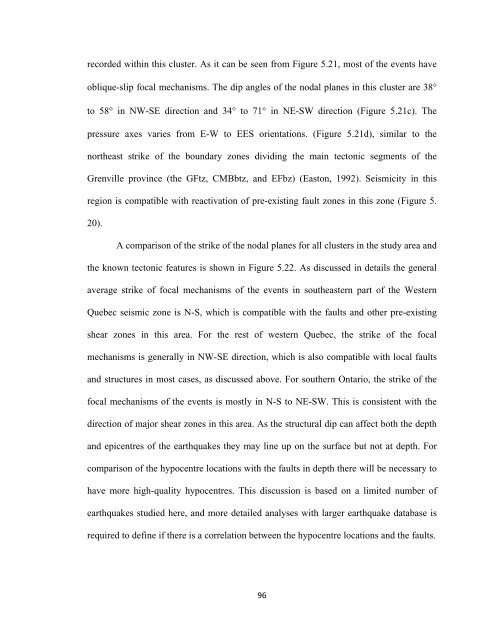western quebec and southern ontario - Department of Geology
western quebec and southern ontario - Department of Geology
western quebec and southern ontario - Department of Geology
Create successful ePaper yourself
Turn your PDF publications into a flip-book with our unique Google optimized e-Paper software.
ecorded within this cluster. As it can be seen from Figure 5.21, most <strong>of</strong> the events haveoblique-slip focal mechanisms. The dip angles <strong>of</strong> the nodal planes in this cluster are 38°to 58° in NW-SE direction <strong>and</strong> 34° to 71° in NE-SW direction (Figure 5.21c). Thepressure axes varies from E-W to EES orientations. (Figure 5.21d), similar to thenortheast strike <strong>of</strong> the boundary zones dividing the main tectonic segments <strong>of</strong> theGrenville province (the GFtz, CMBbtz, <strong>and</strong> EFbz) (Easton, 1992). Seismicity in thisregion is compatible with reactivation <strong>of</strong> pre-existing fault zones in this zone (Figure 5.20).A comparison <strong>of</strong> the strike <strong>of</strong> the nodal planes for all clusters in the study area <strong>and</strong>the known tectonic features is shown in Figure 5.22. As discussed in details the generalaverage strike <strong>of</strong> focal mechanisms <strong>of</strong> the events in southeastern part <strong>of</strong> the WesternQuebec seismic zone is N-S, which is compatible with the faults <strong>and</strong> other pre-existingshear zones in this area. For the rest <strong>of</strong> <strong>western</strong> Quebec, the strike <strong>of</strong> the focalmechanisms is generally in NW-SE direction, which is also compatible with local faults<strong>and</strong> structures in most cases, as discussed above. For <strong>southern</strong> Ontario, the strike <strong>of</strong> thefocal mechanisms <strong>of</strong> the events is mostly in N-S to NE-SW. This is consistent with thedirection <strong>of</strong> major shear zones in this area. As the structural dip can affect both the depth<strong>and</strong> epicentres <strong>of</strong> the earthquakes they may line up on the surface but not at depth. Forcomparison <strong>of</strong> the hypocentre locations with the faults in depth there will be necessary tohave more high-quality hypocentres. This discussion is based on a limited number <strong>of</strong>earthquakes studied here, <strong>and</strong> more detailed analyses with larger earthquake database isrequired to define if there is a correlation between the hypocentre locations <strong>and</strong> the faults.96
















